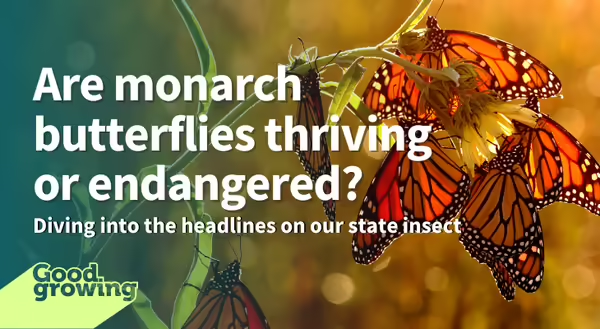
A tale of two articles
Have you read some of the headlines lately concerning monarch butterflies? “Monarch Butterflies are Thriving!” “Monarch Butterflies are Endangered!” Both these headlines (or something similar) recently saturated newsfeeds for Americans. Considering these stories came out about two weeks apart, what is a person to think? Are monarch butterflies okay? Or are they in peril? As you may have gathered with headlines like this, the answer lies somewhere in the middle. Let’s break down each one of these newsmakers.
Are monarchs thriving?
Starting with the first story to break, “Monarchs are Thriving”, if one were to read beyond the headline you would see it’s not all sunshine for our state insect, but there is good news worth sharing. Entomologists from University of Georgia published results from Community Science data that indicated monarch butterfly populations are able to rebound during the summer in the US and Canada.
You may be asking, “Rebound from what?” We can divide monarch butterflies into two types depending on the time of year. There is the breeding population that migrates north in the spring and hangs out with us in Illinois and onward to Canada all summer. These guys live for about two months, but they continue to mate and lay eggs on milkweed increasing the population. Once we hit fall, something changes in the monarch butterfly. They now shift to being migratory and begin the long journey back to their overwintering site in Mexico. These butterflies may live up to eight months! During this journey and at their overwintering site we see a decline in the monarch butterfly population. It is believed lack of nectar to fuel these fluttering beauties and habitat loss is the primary cause.
In summary, the summer breeding population of monarch butterflies is thriving and can overcome the migratory losses and repopulate the species. Yet even the authors of the paper acknowledge that resilience has a limit and we do not know the point where the monarch butterfly will not be able to come back.
What does it mean monarchs have been declared endangered?
The second headline declaring the migratory monarch butterfly endangered was made by the International Union for Conservation of Nature (IUCN). This is a well-regarded organization that makes global declarations on the status of wildlife species. For instance, if you looked up the Indian cheetah, you would see the IUCN has deemed it endangered. The same goes for many of the species seen as endangered around the globe. So this declaration does bear weight, but what does it mean for us in the United States? Well, nothing. The legislation that guides the US in dealing with endangered species is the Federal Endangered Species list. If the monarch butterfly would be listed on this, protections would go into effect for the monarch butterfly.
So why doesn’t the U.S. list the monarch butterfly as endangered?
It would be bad for most of us, even me on occasion. Monarchs are everywhere. It truly is a North American species. A federally protected monarch means the habitat is protected. We couldn’t kill a milkweed plant, because it is the only thing a monarch caterpillar eats. And milkweed grows everywhere! We would no longer be able to use monarch butterflies as teaching tools in schools, rear them indoors, and many more implications.
How do we keep the monarch butterfly off the U.S. endangered species list while still helping?
Create, manage, and preserve more habitat. Especially, habitat providing good fall nectar sources for our migrating monarchs. If you can’t build a pollinator garden, support organizations that do! University of Illinois Extension actively builds and supports monarch butterfly habitats and research. Learn more about one of these initiatives at ipollinate.illinois.edu/.
Good Growing Tip of the Week: There is more to milkweed than common milkweed (Asclepias syriaca). Illinois has over twenty different species of milkweed that all can play host to monarch caterpillars. Check out this Illinois Extension article about the different types and what may work best for your yard. Types of Milkweed
There's a lot more to this story!
Check out our conversation with visiting Extension specialist on pollinators and beneficial insects Brodie Dunn on the Good Growing podcast
Brodie Dunn chats about the recent listing of the monarch butterfly as an endangered species by the IUCN. What does that mean for us in Illinois where monarchs spend their summers? We dive into the most recent scientific publications to determine how the monarch population is doing according to...
Want to get notified when new Good Growing posts are available? SIGN ME UP
MEET THE AUTHOR
Chris Enroth is a horticulture educator with University of Illinois Extension, serving Henderson, McDonough, Knox, and Warren counties since 2012. Chris provides horticulture programming with an emphasis on the home gardener, landscape maintenance personnel, and commercial landscapers. Additional responsibilities include coordinating local county Master Gardener and Master Naturalist volunteers - providing their training, continuing education, advanced training, seasonal events, and organizing community outreach programs for horticulture and conservation assistance/education. In his spare time, Chris enjoys the outdoors, lounging in the garden among the flowers (weeds to most).